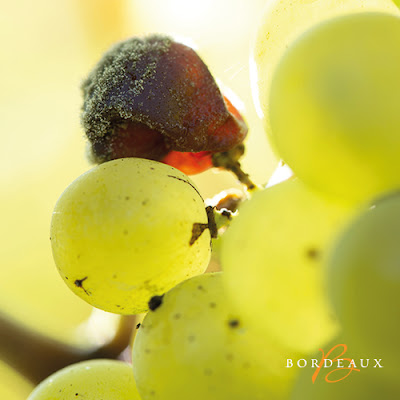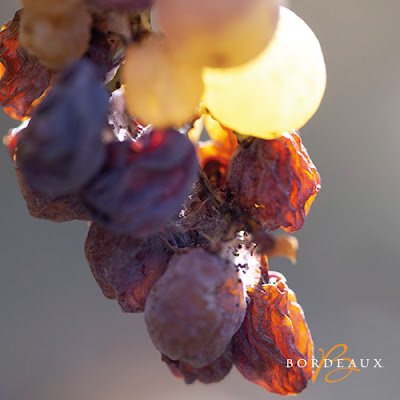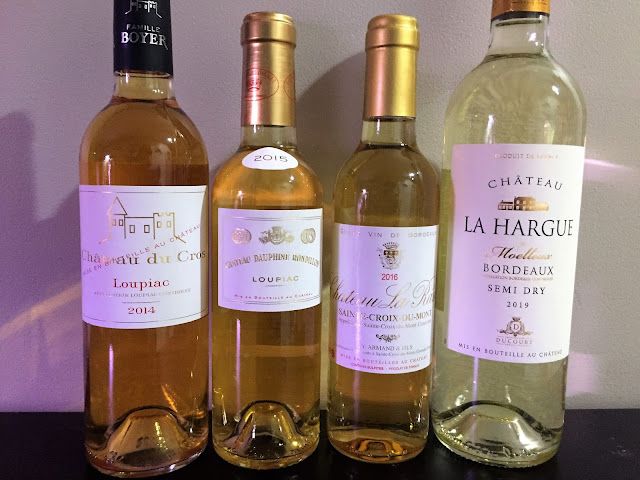I’m thrilled to finally join the French Winophiles group and gain some knowledge into the world of French wine. I’m so immersed typically in Italian wine that branching out here and there is important to get a better grasp on wine from around the world. This month the feature are the sweet wines of Bordeaux, which I’ve written about in the past. If you follow my blog you know I truly enjoy dessert wines so this was a treat.
Sweet Bordeaux wines are primarily made of semillon, sauvignon blanc and/or muscadelle. They are sweeter because the grapes are typically harvested about a month or two after regular harvest of the other grapes. This dehydrates the grapes concentrating the sugars. What makes the sweet wines of Bordeaux special is the fungus known as botrytis cinerea or noble rot. I know it may sound unappealing a fungus growing on the grapes, but it transforms creates complexities in the flavors and aromatics of the grapes lending more toward honey notes. Noble rot develops due to the climate, which in Bordeaux develops from the misty mornings and the heat and humidity of the day.
 |
| Botrytis Cinerea ~ copyright of Bordeaux.com |
 |
| Copyright of Bordeaux.com |
I sampled four wines from 2 of the 8 AOC’s, appellations, in Bordeaux that make sweet wine, Loupiac and Sainte-Croix-du-Mont. Loupiac occupies about 865 acres that located about 18 miles southeast of Bordeaux on the right bank of the Garonne River. It’s hilly terrain made primarily of gravel and chalky clay soils. The appellation follows strict laws around density and even weight of the grapes harvested. Romans were the first that cultivated vines in this area and an ancient Roman villa still exists today that can be visited.
Sainte-Croix-du-Mont is located on the right bank of the Gironde River as well south of Loupiac. The soils here are more limestone with clay on steep hillsides occuping 1,100 acres. The sweet wines of this area are known for being more powerful and intense.
The Wines
2014 Chateau du Cros Loupiac: Part of the wines of Famille Boyer. This wine is made of 90% semillon, 5% sauvignon blanc and 5% muscadet. It spends 12 months in barrique. The most golden in color of the 4 wines. An intense nose mostly of honey and apricot. Rather delicate on the palate, but with concentrated, complex flavors including apricot. A beautiful silkiness to this wine. ABV 13% SRP $15
2015 Chateau Dauphine Rondillon Loupiac: This winery is operated by 8 generations. These grapes are harvested from the oldest vineyards onsite planted in 1910 and are considered the best of their production. The wine is made of 80% semillon and 20% sauvignon blanc and aged for 1 year in barrels that are a year old. Light golden color with a nose lending more towards citrus compared to the previous wine. Elegant and balanced on the palate with the citrus (orange) showing up more on the palette. ABV 13% SRP $25
2016 Chateau La Rame Sainte-Croix-du-Mont: One of the oldest estates of the area. Made of 95% semillon and 5% sauvignon blanc. The grapes spend 2 years in stainless steel with 30% oak. My favorite wine of the group here. Light golden in color. Raisins, apricots and peach showing up on the aromatics. The palette is layered with flavors in harmony showing lots of vanilla with a hint of the raisins and apricot. ABV 13% SRP $34
2019 Chateau La Hargue Moelleux Semi Dry: These vineyards in Entre-Deux-Mers occupies all of the AOC’s and have been part of the family since 1954 acquired by Henri Ducourt. Made of sauvignon blanc, sauvignon gris and semillon and aged on lees in stainless steel. The only full sized 750ml bottle, while the rest are 375ml. Pale straw colored, almost colorless in the glass. The sauvignon blanc shines on the nose showing grassiness. Definitely semi-dry showing up crisp and clean with tropical notes and white peach. ABV 11% SRP $18
 |
| Copyright of Sweetbordeaux.com |
Join us live on Twitter this Saturday @ 11am EST at #winophiles and chat with our food and wine loving friends on more sweet wines of Bordeaux.
- Camilla at Culinary Adventures with Camilla: “Surprise! Pairing Spicy and Savory Dishes with Sweet Bordeaux”
- Terri at Our Good Life: “Spicy Hot Tacos and Sweet Bordeaux”
- Martin at ENOFYLZ: “Pairing Golden Bordeaux with Southern Fare”
- Lauren at The Swirling Dervish: “Golden Bordeaux Meets Savory Pumpkin and Smoked Bacon Tart: a Delicious Thanksgiving Twist!”
- David at Cooking Chat: “Pairings for Sweet Bordeaux Wine
- Katrina at The Corkscrew Concierge: “Golden Bordeaux Delights in Louisiana’s Cajun and Creole Cuisine"
- Jane at Always Ravenous: “Golden Sweet Bordeaux Wines: Tasting and Pairings”
- Wendy at A Day in the Life on the Farm: “Hot Chocolate and Halva Pudding paired with Lion De Tanesse L'Amour”
- Jeff at foodwineclick: "Sweet Bordeaux Meets the Smoke"
- Jill at L’OCCASION: “Sweet Bordeaux Wines Aren’t Just for Dessert”
- Lynn at Savor the Harvest: “Sweet Bordeaux Wines Get Savory Pairings”
- Rupal at Syrah Queen: "Sweet Bordeaux Is A Sweet Delight - Savor These Perfect Food Pairings"
- Robin at Crushed Grape Chronicles: “Sweet Bordeaux Wines and pairings from opposite sides of the globe”
- Pinny at Chinese Food & Wine Pairings: “Sweet Bordeaux Paired with Asian Carbs - Chinese Sticky Rice and Korean Japchae”
- Susannah at avvinare: “Delightful Sweet Wines from Bordeaux”
- Nicole at Somm’s Table: “Château Loupiac Gaudiet with Cinnamon Apple Crème Brûlée”
- Gwendolyn at wine predator: “Successful Pairings of Salty and Savory with Sweet Semi-Dry Bordeaux”
- Linda at My Full Wine Glass: “Appetizer, entrées and yes, dessert please, with sweet Bordeaux”
- Payal at Keep the Peas: “Four Sweet Bordeaux Wines With Four Courses”
*These wines were provided as samples, but opinions are always my own.


